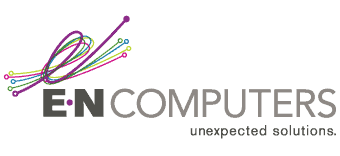

Content Contributor, E-N Computers
7+ years experience in healthcare IT and tech support.
Updated March 18, 2024
Many organizations have a disconnect between business units and IT. Sometimes employees feel that IT doesn’t understand their work experience and frequently puts up roadblocks that cause slowness and disruptions. Or decision makers feel that IT doesn’t really understand or address the needs of the business.
From the perspective of IT, employees are circumventing security protocols designed to protect the company, and management is making technology-dependent decisions without including IT in the process. They may be viewed as a cost center rather than an investment. The result is that the business does not perform as well as it could.
Eliminating this disconnect and improving company performance requires aligning your business and IT strategy, rather than treating them like separate entities. What does business-IT alignment involve? What are some benefits? And how can small businesses achieve alignment? In this article, we will answer those questions.
QUICK ANSWER:
What is Business-IT alignment?
Business IT alignment is an ongoing process of integrating information technology with your business in a strategic way. It can help you reach your business goals, improve your customer experience, and cut IT costs while realizing a higher return on your investments. An MSP with a good strategic planning process can help you get there.
Definition of Business-IT alignment

Why is such a shift necessary? For many businesses, technology is treated as an add-on to the business rather than an integral part of it. Decisions are made on the business side and then IT is told to do whatever is necessary to make that happen at the lowest possible cost. Technology is implemented without really understanding the needs of employees. It can even feel like there is a language barrier thanks to the jargon and buzzwords that dominate each specialty. In the end, the ‘business side’ grumbles because new technology is pushed on them without any regard for existing processes, and the ‘IT side’ grumbles because they weren’t consulted and, based on past experience, they fully expect the results of their labor to be underutilized or left unused.
Resolving the grumbling and inefficient use of time and resources requires a true integration of business and IT. Technology must be viewed as an essential part of the mission and goals of the organization. To accomplish this, the strategic plan of the business is built with the input of a chief information officer (CIO). This collaboration leads to technology solutions that are implemented with consideration for business revenue streams and provide an acceptable return on investment. It also ensures that all parties share and work toward a common goal.

Benefits of business IT alignment

Business goals: Once stakeholders view IT as an integral part of the business, and IT sees its role as supporting and advancing business growth, technology solutions can be optimized for core functions of the business. This means the business can provide better products and services with greater consistency. Because of ongoing collaboration, management and IT will be in a better position to explain the value of implemented solutions to business employees.
Customer service: Rather than presenting roadblocks to employees, properly aligned technologies streamline business processes. This enables team members to more effectively support one another, and improves customer experiences.
IT costs andROI: When technology investments are made on an ad-hoc basis, you tend to have higher spending and an ill-fitting final product. You also end up with mismatched equipment that is more costly to maintain and support. By taking a more holistic, planned approach you will receive stable, scalable, and well-supported solutions that do not duplicate functionality or require excessive capital outlays. And you will be using standardized equipment that is less resource intensive.
Risk management: IT and management come to a mutual understanding on what legal, compliance, and regulatory risks exist for the company. They are then able to decide what business processes and technical solutions need to be implemented to mitigate those risks. They are also able to effectively communicate the risks and mitigation techniques to employees.
Business-IT alignment can help transform your organization. Rather than keeping the traditionally conflicting priorities of business and IT, you can strategically unite the two and take on external competition. You can turn your various working groups into a more unified team by giving them a better understanding of your business strategies and how their use of your IT tools your strategic goals. But how can a small business achieve this level of integration and efficiency?
How small businesses achieve alignment

A managed service provider with a good strategic planning process will provide you with all the IT resources you need to be successful. For example, E-N Computers includes strategic account management and virtual CIO (vCIO) services in all of our managed IT service plans. By means of regular updates, monthly reviews, and annual strategy meetings, we make sure that your information systems are aligned with your business goals and performing optimally. We also work with you to build a technology roadmap and budget that helps you visualize and prepare for future expenses like hardware upgrades, software licenses and subscriptions, and project work.
Meanwhile, our administrative staff provides inventory and license management, project management, and watches for trends in your support requests that may indicate larger issues that need to be addressed. Skilled technicians provide day-to-day support through our help desk and on-site visits, with the backing of experienced engineers for more complex issues.
We have helped dozens of clients to keep technology aligned with their business goals. If you are ready to take a more strategic approach to business and IT, to integrate technology in a way that gives you a competitive edge, contact us today. We will be happy to talk with you about ways to improve your business-IT strategic alignment.
Next Steps: Learn more about managed IT services
Tightly integrating technology with your businesses processes requires a wide range of IT knowledge and skills — not to mention more man-hours than one person can give. We discuss what a properly staffed IT department looks like, and why MSPs are a strong alternative for small businesses in the article, Should I outsource my IT department? The article includes an in-house vs. outsourced IT calculator.
After reading that, the article, What is included in managed IT services?, explains the major components of our fully managed services plan. When you see how all the pieces fit together, you can be confident that everything IT is cared for and you can focus on your organization’s mission. To discuss our services with a member of our team, please contact us.
Take the IT Maturity Assessment

Is your business ready to weather changes, including employee turnover? Find out by taking our IT maturity assessment.
You’ll get personalized action items that you can use to make improvements right away. Plus, you’ll have the opportunity to book a FREE IT strategy session to get even more insights into your IT needs.

Industries
Locations
Waynesboro, VA
Corporate HQ
215 Fifth St.
Waynesboro, VA 22980
Sales: 540-217-6261
Service: 540-885-3129
Accounting: 540-217-6260
Fax: 703-935-2665
Washington D.C.
1126 11th ST. NW
Suite 603
Washington, DC 20001-4366
Sales: 202-888-2770
Service: 866-692-9082
VA DCJS # 11-6604
Locations
Harrisonburg, VA
45 Newman Ave.
Harrisonburg, VA 22801
Sales: 540-569-3465
Service: 866-692-9082
Richmond, VA
3026A W. Cary St.
Richmond, VA 23221
Sales: 804-729-8835
Service: 866-692-9082
